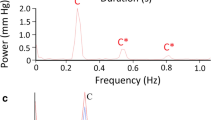Abstract
These experiments were planned with three main objectives. Firstly to look for a reproducible specific effect of raised intracranial pressure (ICP) on ventilation and the pattern of breathing, when distortion of the brain stem was avoided; secondly to investigate the possibility that the ventilatory response to CO2 might alter during raised ICP before other effects on breathing; thirdly to see whether changes in arterial blood gases were consistent with neural effects on pulmonary gas exchange (1, 2, 3).
Supported by a grant to SJ from the Scottish Hospital Endowments Research Trust.
Access this chapter
Tax calculation will be finalised at checkout
Purchases are for personal use only
Preview
Unable to display preview. Download preview PDF.
Similar content being viewed by others
References
BERMAN, I.R., DUCKER, T.B.: Pulmonary somatic and splanchnic circulatory responses to increased intracranial pressure. Ann. Surg. 169, 210–216 (1969).
BRASHEAR, R.E., PAMINTUAN, R.L.: Increased pulmonary diffusing capacity and elevated cerebrospinal fluid pressure. J. Appl. Physiol. 30, 844–846 (1971).
BRACKETT, C.E.: Respiratory complications of head injury. In: GILLINGHAM, J., OBRADOR, S. (eds.): Head Injuries, pp. 255–265. Baltimore: Williams & Wilkins 1971.
READ, D.J.C.: A clinical method for assessing the ventilator response to carbon dioxide. Aust. Ann. Med. 16, 20–32 (1967).
JENNETT, S., SHORT, H.E.: Assessment of respiratory chemosensitivity by a rebreathing method. Brit. J. Anaesth. 45, 119 (1973).
KUURNE, T., TROUPP, H.: Hydrostatically raised intracranial pressure. J. Neurosurg. 37, 695–699 (1972).
HOFF, J., NISHIMURA, M., PITTS, L.: Effect of raised intracranial pressure on pulmonary function in cats. In: This volume, paper G:1.
HOFF, J.T., REIS, D.J.: Localization of regions mediating the Cushing response in CNS of cat. Arch. Neurol. 23, 228–240 (1970).
Editor information
Editors and Affiliations
Rights and permissions
Copyright information
© 1975 Springer-Verlag Berlin Heidelberg
About this paper
Cite this paper
Jennett, S., North, J.B. (1975). Breathing Pattern, Response to CO2 and Blood Gases in Cats with Experimental Increases in Intracranial Pressure. In: Lundberg, N., Pontén, U., Brock, M. (eds) Intracranial Pressure II. Springer, Berlin, Heidelberg. https://doi.org/10.1007/978-3-642-66086-3_66
Download citation
DOI: https://doi.org/10.1007/978-3-642-66086-3_66
Publisher Name: Springer, Berlin, Heidelberg
Print ISBN: 978-3-642-66088-7
Online ISBN: 978-3-642-66086-3
eBook Packages: Springer Book Archive




